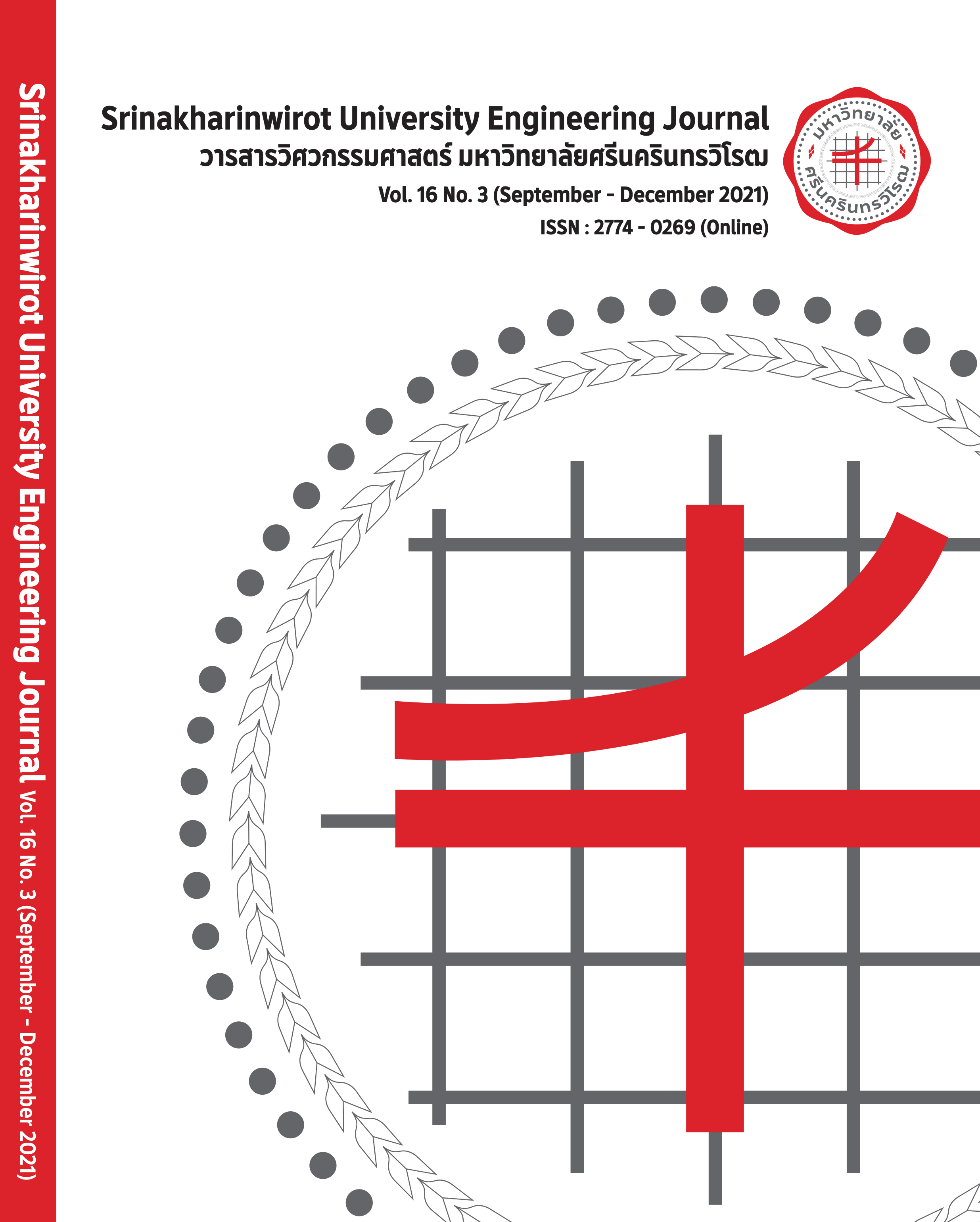Temperature of Recirculation batch drying the paddy had an effect on aroma (2AP)
Main Article Content
Abstract
The aim of this study was to analyze the effect of Thai Pathumthani Fragrant Rice on high temperature in recirculation batch drying. Dimension of drying is 2270 mm in height, 2481 mm in width and 1070 mm in length. It has a capacity of 1.5 tons. Research and development of automatic drying for Thai Pathumthani Fragrant Rice in the form of recirculation batch drying. The properties of the dehumidification temperature were tested and the tested in provided were temperature, time and heat source type. Even though the drying process test results. Each experiment demonstrated that the 2-Acetyl-1-Pyrroline (2AP) evaporation at the drying temperature was 60 ° C, when the temperature increase would reduce the moisture content of rice. Therefore, before drying of Thai Pathumthani Fragrant Rice, the value of 2AP»1.465 micrograms per gram was analyzed, and after recirculation drying, it was 2AP»1.580 micrograms per gram.
Article Details

This work is licensed under a Creative Commons Attribution-NonCommercial-NoDerivatives 4.0 International License.
Copyright belongs to Srinakharinwirot University Engineering Journal
References
R. G. Buttery, L. C. Ling, B. O. Juliano and J. G. Turnbaugh, “Cooked Rice Aroma and 2-Acetyl-1-pyrroline”, J. Agric. Food Chem., vol.31, no.4, pp. 823-826, 1983.
T. Yoshihashi, T. H. Nguyen and N. Kabaru, “Area dependency of 2-acctyl-1-pyrroline content in an aromatic rice variety Khao Dawk Mali 105”, Agricultural Sciences (JIRCAS), vol. 38, no.2, pp. 105-109, 2004.
S. Mahatheeranont, S. Promdang and A. Chiampiriyakul, “Volatile Aroma Compounds of Khao Dawk Mali 105”, Kasetsart J. (Nat. Sci.), vol. 29, pp. 508-514, 1995.
S. Mahatheeranont, S. Keawsaard and K. Dumri, “Quantification of the rice aroma compound 2-acetyl-1-pyrroline in uncooked Khao Dawk Mali 105 brown rice”, J. Agric. Food Chem., vol. 49, pp. 773-779, 2001.
S. Thanasookprasert, T. Swasdisevi, S. Devahastin and S. Soponronnarit, “Dehydration of Unhusked Rice by using Impinging Stream Dryer”, Journal of Science and Technology, vol.1, pp. 2, 2012.
A. Taweerattanapanish,“Operating condition of fluidized bed dryer for increasing paddy quality”, M. Eng. dissertation, Dept. Mech. Eng., Kmutt Univ., Thonburi, Thailand, 1997.
T. Itani, M. Tamaki, Y. Hayata, T. Fushimi and K. Hashizume, “Variation of 2-Acetyl-1-Pyrroline Concentration in Aromatic Rice Grains Collected in the Same Region in Japan and Factors Affecting Its Concentration”, Plant Prod. Sci., vol.7, no.2, pp. 178-183, 2004.
M. D. Pearce B, P. Marks J and F. Meullenet, “Effects of Postharvest Parameters on Functional Changes During Rough Rice Storage”, Cereal chemistry, vol.78, pp. 354-357, 2001.
B. G. Lyon, E. T. Champagne, B. T. Vinyard and W.R. Windham, “Effects of Degree of Milling, Drying Condition and Final Moisture Content on Sensory Texture of Cooked Rice”, Cereal chemistry, vol.76, pp. 56-62, 1999.
S. Wongpornchai, K. Dumri, S. Jongkaew-wattana and B. Siri, “Effects of drying methods and storage time on the aroma and milling quality of rice (Oryza sativa L.) cv. Khao Dawk Mali 105”, Food Chemistry, vol. 87, pp. 407-414, 2004.
N. Sunthonvit, G. Srzednicki and J. Craske, “Effects of High-Temperature Drying on the Flavor Components in Thai Fragrant Rice”, Drying Technology, vol.23, no.7, pp. 1407-1418, 2005.
K. Sungareeyakul, “Evaluation of Status of Paddy Dryers in Thailand”, M. eng. dissertation, Dept. Eng., Kmutt Univ., Thonburi, Thailand, 2001.
W. Rordprapat, S. Soponronnarit and M. Wangji, “Paddy Drying Systems in Rice Mills”, Kasetsart J. (Nat. Sci.), vol.33, pp. 126 –133, 1999.
S. Soponronnarit, “Drying of grains” in Energy Management Technology, King Mongkuts University of Technology, Graduate School, 1997, pp. 144-163.
W. Kwaku Kalla, “Design Development and Evaluation of a Continuous- Flow Mixing Grain Dryer”, BSC. dissertation, Dept. Agr. Eng., Kwame Nkrumah Univ., Zanbia, 2011.


